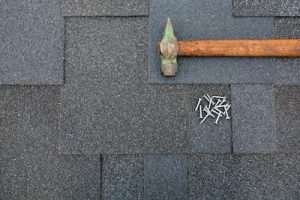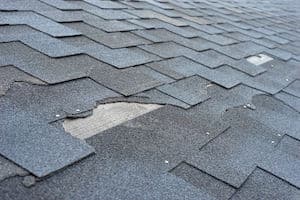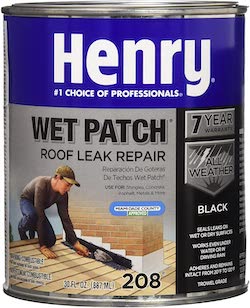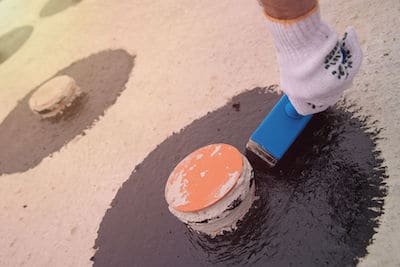What is Roofing Cement?
If you’re a homeowner, you know that maintaining your roof is essential to protecting your investment. Whether you’re dealing with a small leak or a more extensive repair, roofing cement is a valuable tool in your toolbox. But what is roofing cement, and how do you use it? In this article, we’ll answer these questions and more to help you tackle your next roof repair project with confidence.
When you think of the components of any roof there are a few main elements that probably come to mind. Shingles, roofing paper, nails, flashing, and necessary tools are probably the items that you think of. However, if your roof is simply needing a small repair, these tools may not be necessary!
What is roofing cement? Roofing cement, also known as roof cement, is a thick, adhesive substance that is used to seal and repair roofs. It is made up of a mixture of asphalt, fibers, and mineral fillers, which work together to create a durable, waterproof seal. Roofing cement is available in both wet and dry forms, and it can be applied with a trowel, brush, or caulking gun. Using roofing cement to repair damaged areas of a roof can save the homeowner both time and money. However, there are a few things you should be aware of before you decide to use roofing cement on your roof.
When to Use Roofing Cement
- Patching holes and leaks in all types of roofing materials.
- Repairing the metal components of a roof such as gutters or trim that may be rusting.
- Securing the flashing around chimneys to stop leaks.
- Repairing cracks in concrete roofs.
- Reattaching loose shingles or replacing solitary shingles that are missing.
- Cover Rust Spots
As you can see, roofing cement is multifaceted and can easily solve many issues that may present themselves in an older roof. Using roofing cement to repair your roof as needed will prevent further damage from occurring. It can even prolong the lifetime of your roof, saving you thousands of dollars.
Types of Roofing Cement
There are several types of roofing cement available, each with its own unique properties and uses. Some of the most common types include:
- Asphalt Roof Cement: This is the most common type of roofing cement and is often used to repair asphalt shingle roofs. It is easy to apply, dries quickly, and is resistant to water and UV rays.
- Butyl Rubber Roof Cement: This type of roofing cement is made from a blend of butyl rubber and asphalt. It is highly elastic, making it an excellent choice for roofs that expand and contract with temperature changes.
- Silicone Roof Cement: Silicone roofing cement is ideal for repairing flat or low-slope roofs. It is highly resistant to water and UV rays and can be applied in extreme temperatures.
- Modified Bitumen Roof Cement: This type of roofing cement is made from asphalt and rubber modifiers. It is designed to be applied in multiple layers and can be used to repair a variety of roofing materials.

How to Use Roofing Cement
Using roofing cement is relatively straightforward, but there are a few steps you should follow to ensure that your repair is successful. Here’s a step-by-step guide:
- Clean the Surface: Before applying roofing cement, you’ll need to clean the surface thoroughly. Use a broom or brush to remove any debris or loose material, and then use a pressure washer or hose to clean the surface.
- Prepare the Surface: Once the surface is clean and dry, you’ll need to prepare it for the roofing cement. Apply a layer of primer or sealer to the surface and allow it to dry completely.
- Apply the Roofing Cement: Using a trowel or brush, apply a thick layer of roofing cement to the damaged area. Make sure that the cement extends past the damaged area to ensure a watertight seal.
- Smooth the Cement: Once the roofing cement is applied, use a trowel or putty knife to smooth out the surface. Make sure that the surface is level and free of any bumps or ridges.
- Allow the Cement to Dry: Depending on the type of roofing cement you’re using, it may take several hours or even days to dry completely. Be patient and allow the cement to dry before moving on to the next step.
- Apply a Second Coat: If necessary, apply a second coat of roofing cement to ensure a watertight seal. Repeat steps 4 and 5 until the damaged area is completely covered.
When to Avoid Using Roofing Cement
Although roofing cement is an easy fix for many types of roof repairs, there are times when it will cause further damage to your roof. Because of this, it is best to consult a professional roofing company to repair your damaged roof in the most effective manner.
What is Roofing Cement Made Out of?
Roofing cement is a composition of minerals, solvents, fillers and mostly asphalt. The combination of these ingredients make it adhere to and asphalt shingle surface. The ingredients create a bond that can cover a hole and keep water out of the surface below.
Several types of common roofing materials are simply incompatible with the ingredients that make up roofing cement. Chemicals found in roofing cement will damage certain types of plastics used in roofing such as PVC or EPDM. In addition to this, roofing cement is not compatible with metal roofing as it will be ineffective in repairing damages.
Roofing Cement Weather Conditions
Roofing cement is a multi-purpose repair compound. Because of this, it is formulated to be used in a variety of weather conditions. In many cases, roofing cement is the go-to solution for emergency roof repairs during storms or other inclement weather. This is because it is designed to adhere to wet surfaces.
However, just because it works when used in inclement conditions doesn’t mean it should be. If it is within your control, roof repairs should always occur during dry weather. This provides the roofing cement adequate time to dry, creating the most sturdy repairs.
In addition to the fact that roofing cement works most effectively in dry weather, it is also much more safe to make repairs during dry days. Even professional roofing contractors put themselves at risk while repairing roofs during wet weather. Roof repairs should never be done during storms unless it is an emergency roof repair done by a professional roofing company.
How long does it take for Roofing Cement to Dry?
Based on normal weather conditions between 60 degrees and 80 degrees F it takes approximately 2 hours to become hard and 24 hours to fully dry and seal your roof.
Brands of Roofing Cement
All types of roofing cement contain a few key components. These include asphalt, mineral spirits, reinforcing fibers, and plasticizers. However, there are many varieties of roofing cement that are used in different situations.
Specific formulas of roofing cement cater to wet or dry surfaces. Using a roofing cement that is designed for your situation will result in the best, most long-lasting repairs. In addition to wet and dry formulas, roofing cement also comes in a variety of colors to blend in with your existing roof.
Because there are so many types of roofing cement, it is best to work with a professional roofing contractor to determine which is best for your situation. A roofing company will have the knowledge necessary to make this important decision as well as access to several varieties of roofing cement.
Henry HE208030 Roof Cement, Classic Assorted
Henry CO TV205696 Premie 11 oz Roof Cement

Check Price
Notes for Henry’s Roof Cement:
Does Henry’s stop leaks? Stops leaks instantly, even in standing water
What is the ideal temperature to apply it? Apply from 0°F to 120°F (-18°C to 49°C)
Does it have 100% wet surface adhesion? Yes, it has 100% wet surface adhesion per ASTM D3409.
Does it blister or sag? No blistering, sagging or sliding per ASTM D4586.
Is it flexible? Rubberized for improved flexibility and durability
Does it have a warranty? 10-year limited warranty
Tools to Apply Roofing Cement
The application of roofing cement is rather simple. First, one must determine which type of roofing cement is best for their situation. After this decision has been made, make sure that the area needing repairs is clean and free of dust, dirt, or other debris.
Next, the roofing cement is applied to the damaged area using a trowel or a putty knife. Thin coats of roofing cement ensure maximum efficacy. Each layer of roofing cement must dry for 12 hours to be sure that it is completely set.
Areas requiring more in-depth repairs will need multiple layers of roofing cement. If the damage to a roof is a large hole or significant crack, additional material will be necessary. Using rolled roofing, polyester, or fiberglass fabrics, in addition to the roofing cement, in these situations adds strength and durability.
Although the application process of roofing cement is straight-forward, it is always a wise idea to hire a professional roofing company to make these repairs. In addition to their expertise in the area, they also have the proper safety equipment and training.
What are Some Roof Cement Alternatives?
In most roof repair situations, the use of roof cement is the quickest and most time-effective solution. However, if there are multiple areas of the roof that require repair, you may consider an alternative.
If the roof of your home is outdated or in poor condition, it may be a better decision to invest in replacing the roof entirely. Doing so with a reputable roofing company will provide you with a roof that is reliable. In addition to this, most professional roofing companies provide their customers with a warranty that will cover roof damage in the future.
A professional roofing company is able to easily assess the condition of your roof and do a full roof inspection. After doing so, they will determine whether using roofing cement to make repairs or replacing the roof is a better decision. Because this is a rather large investment and plays such a large role in keeping your family safe, it is wise to consult several roofing companies before choosing one to work with.
Never hire a roofing company that is pressuring you into replacing your entire roof for an issue that could be easily fixed using roofing cement. A reliable and honest roofing contractor will be able to easily explain your situation and provide you with the pros and cons of both replacing the roof or using rooftop cement to make a repair.
Cost of Investment
One of the primary reasons that homeowners attempt DIY roof repairs is the cost of investment. It is a common misconception that professional roof repairs will be expensive. However, this is not always the case!
If your roof is in need of repair, first investigate the warranty on your roof. Many roof warranties are valid for 20 years or even more after the initial installation. Necessary roof repairs may be included in this warranty, depending on the roofing company which was used.
However, even if you must spend money to hire a roofing company for your repairs, it is always worth the investment. DIY roof repairs often take a lot of time due to the lack of experience of the homeowner. In addition to this, the failure to follow the correct repair procedure can create further damage.
In many situations, homeowners who attempt DIY roof repairs using roofing cement must eventually hire roofing professionals to correct their failed attempts. This creates a process that is lengthy and expensive.
Safety when Applying Roofing Cement
As you can imagine, any roof repair comes with a level of risk. Although using roofing cement to make a quick repair may seem like a safe procedure, there are many things that can go wrong. Failing to use the proper roofing safety equipment and protocols can lead to serious injury.
Professional roofing contractors have extensive training on using the proper safety protocol, even when completing a simple repair using roofing cement. In addition to this, they own the correct equipment and tools necessary to make the entire procedure a safe one.
Should I Hire a Professional to Apply Roofing Cement?
Most homeowners are tempted to turn important home repairs into Do-It-Yourself projects. In some cases, DIY repairs are okay. There are many home repair projects that can be easily done by someone with little experience. However, roofing is not one of those areas.
Roofing cement is a valuable tool in the roofing industry. For many professional roofing contractors, this is a go-to method for repairs. Roofing cement is useful for fixing cracks, holes, leaks, rust, and other types of roof damage.
The formula that is used to create roofing cement makes it one of the best ways to repair roofs in emergency situations. Because roofing cement adheres to wet or damp surfaces, it can prevent serious damage to your home in the middle of a rainy season.
Hiring a professional roofing company is always the best way to ensure that your roof repairs effective as well as efficient. Although roofing cement makes the repair process rather simple, it is still something that should not be attempted by the average homeowner.
In addition to the expertise that roofing professionals provide when it comes to roof repairs, they are also able to complete the repairs quickly. Using roofing cement can be a lengthy process, which eats into your valuable free time. Let the professionals handle your roofing repairs in a way that is both quick and effective.

Pros of Roofing Cement
- Affordable: Roofing cement is relatively inexpensive, making it an affordable option for DIY roof repairs.
- Easy to Apply: Roofing cement can be applied with a trowel, brush, or caulking gun, making it easy for even novice DIYers to use.
- Durable: Once applied, roofing cement forms a strong, waterproof seal that can last for years.
- Versatile: Roofing cement can be used to repair a variety of roofing materials, including asphalt shingles, metal roofs, and flat roofs.
- Resistant to Weathering: Roofing cement is resistant to a range of weather conditions, including UV rays, extreme temperatures, and rain.
Cons of Roofing Cement
- Not Suitable for Large Repairs: While roofing cement is an excellent option for small repairs, it is not recommended for more extensive repairs or complete roof replacements.
- Not Ideal for Steep Roofs: Roofing cement is difficult to apply to steep roofs, as it can slide off the surface and create a mess.
- Not Environmentally Friendly: Some types of roofing cement contain harmful chemicals that can harm the environment.
- Can Crack or Peel Over Time: While roofing cement is durable, it can crack or peel over time, especially if it is exposed to extreme weather conditions.
FAQ
1. What is the best type of roofing cement to use for a flat roof?
Silicone roofing cement is an ideal choice for flat roofs, as it is highly resistant to water and UV rays and can be applied in extreme temperatures.
2. How long does roofing cement take to dry?
The drying time for roofing cement can vary depending on the type of cement and weather conditions. Generally, it can take anywhere from a few hours to a few days to dry completely.
3. Can I use roofing cement to repair a metal roof?
Yes, roofing cement can be used to repair a variety of roofing materials, including metal roofs.
4. Is roofing cement safe to use?
Roofing cement is generally safe to use, but it can contain harmful chemicals. It’s important to read the label and follow safety instructions when using roofing cement.
5. Is roofing cement waterproof?
Yes, roofing cement is designed to be waterproof. Roofing cement is composed of compound that is designed to prevent leaks and keep the surface below dry. Extreme weather can cause it to become dry and crack as it ages and loose it’s waterproofing ability.
6. Does Roof Cement Harden?
Rooftop cement needs no curing time and is ready for shingles immediately. You can do an asphalt patch in about a day if the weather permits it. Roof cement can harden over time when they are exposed to the elements. It can become dry and brittle after several years of exposure to the sun.
7. How long does roofing cement last?
Roofing cement is a durable material that can be used to repair a number of roofing issues. Although it is an excellent repair solution, it is not as durable as other roofing materials. Roofing cement lasts between 3 to 7 years. This depends on the efficacy of its application, the area in which it is used, and the surface on which it is applied.
8. Can you paint over roofing cement?
Although there are several colors of roofing cement available, many homeowners decide to paint the roofing cement to better match the existing roof. This step is not a requirement, however, it is possible! Many homeowners decide to paint roofing cement during home remodels or when changing the overall design of the home. This can create a look for your home and roof that is more cohesive and aesthetically pleasing.
When painting over roofing cement, it is important to use the proper materials and procedures. First, you must pressure wash the area, making sure it is completely dry and free of all debris. Once this is done, you can prime the area and then follow with a high-quality, 100% acrylic paint.
Conclusion
Roofing cement is an excellent tool for DIY roof repairs, but it’s essential to understand what it is and how to use it correctly. By following the steps outlined in this article, you can repair your roof with confidence and ensure that your investment is protected for years to come. Remember to choose the right type of roofing cement for your repair needs and to follow safety instructions when using the product. With a little bit of know-how and some elbow grease, you can tackle any roof repair project with ease.



